All 65 entries tagged Travel And Motorcycles
Bikes, babes and seeking thereof
No other Warwick Blogs use the tag Travel And Motorcycles on entries | View entries tagged Travel And Motorcycles at Technorati | View all 20 images tagged Travel And Motorcycles
March 21, 2007
Lawrence in training to go RTW by motorcycle
Follow-up to Jupiter's Travels by Ted Simon – a really great book of travel or migration from Transversality - Robert O'Toole
Ted Simon probably wouldn’t mind (he let me sit on his R100GS), but the security guard certainly did. However Lawrence absolutely insisted upon climbing up onto the Triumph Tiger made famous in Jupiter’s Travels:
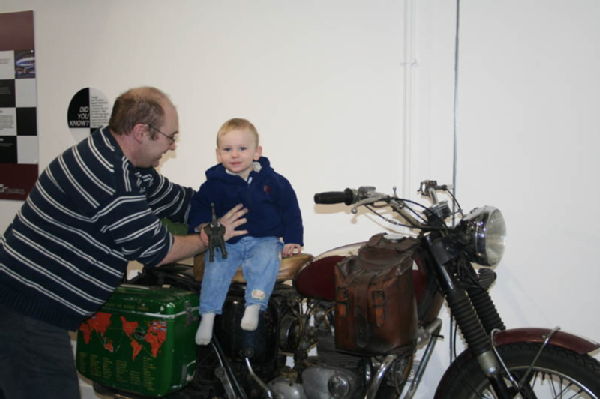
And here’s a photo of me on Ted’s GS:
The Long Way Round expedition by Charley Boorman and Ewan McGregor was a genuinely tough RTW, leaving many scars on this R1150GS Adventure, including some rather neat welding to the rear subframe carried out in Mongolia. Lawrence of course prefers the old Airhead R100GS, but was happy to pose next to Charlie’s bike:
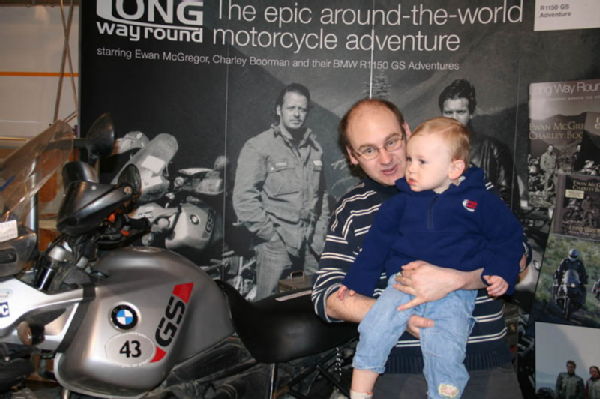
Equipment list for Easter expedition
My GS will be loaded up with its full luggage set. That provides plenty of space:
- 33 litres in the Touratech Zega top box (TP);
- 46 litres in the left Tesch pannier (LP);
- 46 litres in the right Tesch pannier (RP);
- 45 litres in the Touratech V45 tank bag (TB);
- 2.5 litres in the built in glove box (GB);
- 1 litre in the underseat tool box;
- 35 litres in an Ortlieb dry bag (OB);
- some extra space on the rear seat for large/long items (RS).
A total of 208.5 litres of covered storage. If that were completely filled, and accompanied by 35 lites of fuel, it would most certainly be far too much. But that’s not the plan. Four rules apply when packing for motorcycle camping: 1. take all of the essentials; 2. keep weight to a minumum; 3. distribute weight low and evenly; 4. pack so that any item can be retrieved without every other item having to first be unpacked. Hence my approach is to have far more luggage capacity than I actually need.
Camping
- a lightweight one man tent with pegs (RS);
- tent mallet (can this be replaced with something smaller?);
- combined torch and tent-light;
- mini maglight;
- self inflating sleeping mat (RS);
- small pillow;
Wardrobe
- five pairs of boxer shorts;
- five pairs of socks;
- three t-shirts;
- one short sleeved shirt;
- swimming shorts;
- one pair of BMW summer motorcycle trousers;
- one pair of Heine Gericke Air desert motorcycle trousers;
- one Heine Gericke Tuareg armoured jacket, without Gore-Tex liner;
- one pair of Diadora motocross boots;
- desert boots;
- one pair of Heine Gericke brown leather gloves;
- one pair of Heine Gericke windstopper glove liners;
- BMW Sports Integral helmet;
- Hein Gericke Tuareg waist bag;
- four sets of foam earplugs;
Kitchen
- Coleman petrol stove;
- plate, fork, knife, spoon, cup;
- 2.2 litre Camelback water carrier;
- box of matches;
Bathroom
- one small towel;
- toothbrush;
- small toothpaste;
- soap;
- small medicine kit;
Office and photography
- watch;
- small digital camera;
- binoculars;
- Palm M515;
- Palm keyboard;
- mobile phone (check coverage);
- phone car charger;
- camera battery charger;
- BMW power socket converter;
- paper notebook;
- Nikon F50 SLR with 80-300mm lens;
- 35mm film;
Navigation
- Magellan Palm GPS;
- map measurer;
- compass;
- maps;
Bike tools
- electric tyre pump (RP);
- Ultraseal tyre sealant (RP);
- disc lock;
- security chain and lock (RS);
- wheel spanner;
- allen keys;
- screwdriver set;
- 1 litre of engine oil (LP);
Documents
- driving licence;
- V5;
- E111;
- insurance certificate;
- passport;
- credit cards;
- tickets;
- travel insurance documents;
- contact details.
February 11, 2007
The Road – motorcycle riding and writing by T.E. Lawrence
The Mint is an extraordinary but often overlooked book. Deliberately rough and forthright, it gives an account of the time spent by T.E. Lawrence as an ordinary cadet and airman in the RAF (hiding under the alias T.E. Ross). There is little joy or freedom in the book. The author seeks out the supression of self that is service, so as to demonstrate, amongst other things, the near moral bankruptcy of the British military post-WWI. However, amidst the depression and squalor, towards the end of the memoirs (and once posted to the much more salubrious Cranwell College), the following chapter stands out.
Lawrence had by this time (1925-26) become an aircraft engineer with experience and knowledge. He found something in this work that even surpassed his time amongst the leadership of the Arab Revolt. Fast machines and freedom. And most of all, motorcycles. This generated perhaps one of the best accounts written of a motorcycle journey. We are given the impression that this exhilerating ride is nothing but an everyday occurence. And no doubt with the fresh tarmac and empty roads of the mid-Thirties, it was just that. These days one rarely has a chance to experience the road in this way, and certainly not to duel with a Bristol Fighter above. Motorcyle safety has also improved somewhat. Lawrence’s Brough Superior, perhaps the 30’s equivalent of a modern Suzuki Hayabusa hyper-sports tourer, had almost no brakes, almost no suspension, and a hand gear change making engine braking a terrifying prospect. And yet it gave 52bhp – almost as much as my R100GS. The rider wore no helmet and no goggles. And certainly no kevlar body armour. And he still pushed it so hard that the bike lunged into a near fatal tank slapper.
Ten years later a similar event led to his death.
One of the greatest accounts of a motorcycle ride…

The Road
The extravagance in which my surplus emotion expressed itself lay on the road. So long as roads were tarred blue and straight; not hedged; and empty and dry, so long I was rich.
Nightly I’d run up from the hangar, upon the last stroke of work, spurring my tired feet to be nimble. The very movement refreshed them, after the day-long restraint of service. In five minutes my bed would be down, ready for the night: in four more I was in breeches and puttees, pulling on my gauntlets as I walked over to my bike, which lived in a garage-hut, opposite. Its tyres never wanted air, its engine had a habit of starting at second kick: a good habit, for only by frantic plunges upon the starting pedal could my puny weight force the engine over the seven atmospheres of its compression.
Boanerges’ first glad roar at being alive again nightly jarred the huts of Cadet College into life. ‘There he goes, the noisy bugger,’ someone would say enviously in every flight. It is part of an airman’s profession to be knowing with engines: and a thoroughbred engine is our undying satisfaction. The camp wore the virtue of my Brough like a flower in its cap. Tonight Tug and Dusty came to the step of our hut to see me off. ‘Running down to Smoke, perhaps?’ jeered Dusty; hitting at my regular game of London and back for tea on fine Wednesday afternoons.
Boa is a top-gear machine, as sweet in that as most single-cylinders in middle. I chug lordlily past the guard-room and through the speed limit at no more than sixteen. Round the bend, past the farm, and the way straightens. Now for it. The engine’s final development is fifty-two horse-power. A miracle that all this docile strength waits behind one tiny lever for the pleasure of my hand.
Another bend: and I have the honour of one of England’ straightest and fastest roads. The burble of my exhaust unwound like a long cord behind me. Soon my speed snapped it, and I heard only the cry of the wind which my battering head split and fended aside. The cry rose with my speed to a shriek: while the air’s coldness streamed like two jets of iced water into my dissolving eyes. I screwed them to slits, and focused my sight two hundred yards ahead of me on the empty mosaic of the tar’s gravelled undulations.
Like arrows the tiny flies pricked my cheeks: and sometimes a heavier body, some house-fly or beetle, would crash into face or lips like a spent bullet. A glance at the speedometer: seventy-eight. Boanerges is warming up. I pull the throttle right open, on the top of the slope, and we swoop flying across the dip, and up-down up-down the switchback beyond: the weighty machine launching itself like a projectile with a whirr of wheels into the air at the take-off of each rise, to land lurchingly with such a snatch of the driving chain as jerks my spine like a rictus.
Once we so fled across the evening light, with the yellow sun on my left, when a huge shadow roared just overhead. A Bristol Fighter, from Whitewash Villas, our neighbour aerodrome, was banking sharply round. I checked speed an instant to wave: and the slip-stream of my impetus snapped my arm and elbow astern, like a raised flail. The pilot pointed down the road towards Lincoln. I sat hard in the saddle, folded back my ears and went away after him, like a dog after a hare. Quickly we drew abreast, as the impulse of his dive to my level exhausted itself.
The next mile of road was rough. I braced my feet into the rests, thrust with my arms, and clenched my knees on the tank till its rubber grips goggled under my thighs. Over the first pot-hole Boanerges screamed in surprise, its mud-guard bottoming with a yawp upon the tyre. Through the plunges of the next ten seconds I clung on, wedging my gloved hand in the throttle lever so that no bump should close it and spoil our speed. Then the bicycle wrenched sideways into three long ruts: it swayed dizzily, wagging its tail for thirty awful yards. Out came the clutch, the engine raced freely: Boa checked and straightened his head with a shake, as a Brough should.
The bad ground was passed and on the new road our flight became birdlike. My head was blown out with air so that my ears had failed and we seemed to whirl soundlessly between the sun-gilt stubble fields. I dared, on a rise, to slow imperceptibly and glance sideways into the sky. There the Bif was, two hundred yards and more back. Play with the fellow? Why not? I slowed to ninety: signalled with my hand for him to overtake. Slowed ten more: sat up. Over he rattled. His passenger, a helmeted and goggled grin, hung out of the cock-pit to pass me the ‘Up yer’ Raf randy greeting.
They were hoping I was a flash in the pan, giving them best. Open went my throttle again. Boa crept level, fifty feet below: held them: sailed ahead into the clean and lonely country. An approaching car pulled nearly into its ditch at the sight of our race. The Bif was zooming among the trees and telegraph poles, with my scurrying spot only eighty yards ahead. I gained though, gained steadily: was perhaps five miles an hour the faster. Down went my left hand to give the engine two extra dollops of oil, for fear that something was running hot: but an overhead Jap twin, super-tuned like this one, would carry on to the moon and back, unfaltering.
We drew near the settlement. A long mile before the first houses I closed down and coasted to the cross-roads by the hospital. Bif caught up, banked, climbed and turned for home, waving to me as long as he was in sight. Fourteen miles from camp, we are, here: and fifteen minutes since I left Tug and Dusty at the hut door.
I let in the clutch again, and eased Boanerges down the hill along the tram-lines through the dirty streets and up-hill to the aloof cathedral, where it stood in frigid perfection above the cowering close. No message of mercy in Lincoln. Our God is a jealous God: and man’s very best offering will fall disdainfully short of worthiness, in the sight of Saint Hugh and his angels.
Remigius, earthy old Remigius, looks with more charity on and Boanerges. I stabled the steel magnificence of strength and speed at his west door and went in: to find the organist practising something slow and rhythmical, like a multiplication table in notes on the organ. The fretted, unsatisfying and unsatisfied lace-work of choir screen and spandrels drank in the main sound. Its surplus spilled thoughtfully into my ears.
By then my belly had forgotten its lunch, my eyes smarted and streamed. Out again, to sluice my head under the White Hart’s yard-pump. A cup of real chocolate and a muffin at the teashop: and Boa and I took the Newark road for the last hour of daylight. He ambles at forty-five and when roaring his utmost, surpasses the hundred. A skittish motor-bike with a touch of blood in it is better than all the riding animals on earth, because of its logical extension of our faculties, and the hint, the provocation, to excess conferred by its honeyed untiring smoothness. Because Boa loves me, he gives me five more miles of speed than a stranger would get from him.
At Nottingham I added sausages from my wholesaler to the bacon which I’d bought at Lincoln: bacon so nicely sliced that each rasher meant a penny. The solid pannier-bags behind the saddle took all this and at my next stop a (farm) took also a felt-hammocked box of fifteen eggs. Home by Sleaford, our squalid, purse-proud, local village. Its butcher had six penn’orth of dripping ready for me. For months have I been making my evening round a marketing, twice a week, riding a hundred miles for the joy of it and picking up the best food cheapest, over half the country side.
The full text of The Mint can be found online.
February 04, 2007
Why travel by motorcycle?
Follow-up to Jupiter's Travels by Ted Simon – a really great book of travel or migration from Transversality - Robert O'Toole
Because things like this happen…
Arriving at a hotel in Peru, no doubt looking somewhat worn out by a hard ride across South America, Ted Simon is pleased to be given a discount:
‘Por essos que llegen en coche, ochenta. Pero essos en moto son muy hombre,’ said the clerk with a grin. In other words, car drivers pay the full rate but there is a discount for heroes. p.288
Heroes deserve discounts!
January 22, 2007
Balancing a Bing and other esoteric BMW motorcycle restoration rituals
Follow-up to Exhaust[ion] from Transversality - Robert O'Toole
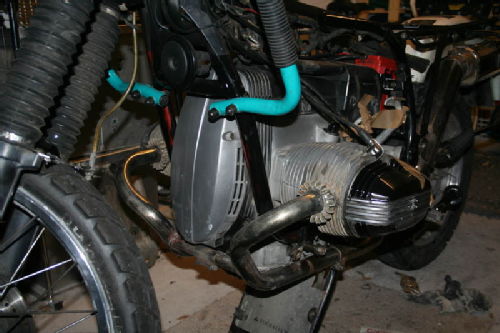
Engine cleaning
The most important task was to clean up the engine casings. I’m not trying to create a show bike. Rather, I needed to get rid of the thick layer of road grime and old oil, so that I will be able to spot fresh oil leaks more easily. Whilst doing this, I gave some of the surfaces a polish with Autosol and wire wool – yes wire wool – the old airhead GS engine is almost bare alluminium, so can be treated a little more roughly than a modern bike. The cylinder cover fins were scrubbed even more aggresively, using a long bristled steel brush. A build up of grime in the fins may actually lead to overheating – the engine is air-cooled, so needs to transfer heat outwards as efficiently as possible.
Frame
With all of the crash bars and bash plates off, I could also clean the frame, remove a substantial amount of rust, and repaint. I did an acceptable job of saving the metal from further damage in the short term, but it looks as if it will need a professional treatment soon. Powder coating will be worth it. The lower fork bridge and the battery cage also scrubbed up well, and now sport a shiny black coat of Hammerite. Less sucessful was my attempt at repainting the valve covers with high-temperature paint. I think i’ll just strip them back to the silver alluminium, and maybe even replace the left hand cover with a Touratech cover (with built in oil filler). As for the severely battered right hand engine bar, having taken the brunt of most of my off road falls, I can’t save it but haven’t yet sourced a replacement.
Exhaust
As can be seen from the photo, the downpipes were replaced with ones bought for a bargain £40 from Motorworks . Part of the old pipes seized solidly into the y-piece, necessitating its replacement with a new Keihan pipe from Motobins – £130 – rather expensive, but it is nice and shiny. The silencer still seems fine. I can’t find a replacement for the excellent Laser Produro, so will keep it on for as long as possible.
Rough running
Replacing the heavily corroded left hand spark lead has been just the first step in sorting my engine problems. The bike started up first time, ran well for a while, but then started running roughly. Prodding the carb mechanisms revealed that they were sticking badly: perhaps the most common cause of engine problems in the airhead beemers. The big Bing carbs are completely exposed to the elements, sitting just behind the flat twin boxer cylinders as they stick out the sides of the bike. The external throttle and choke mechanisms, if run in the British winter, soon fill up with black gritty road grime. Rough running, over fast idling, and even serious engine damage (like the burnt out valve that I once suffered) may result.
To solve the problem I removed each carb from between the engine and the airbox, turned it around so that I could access the dark side of the carb, and scrubbed it well. This photo illustrates a clean unit:
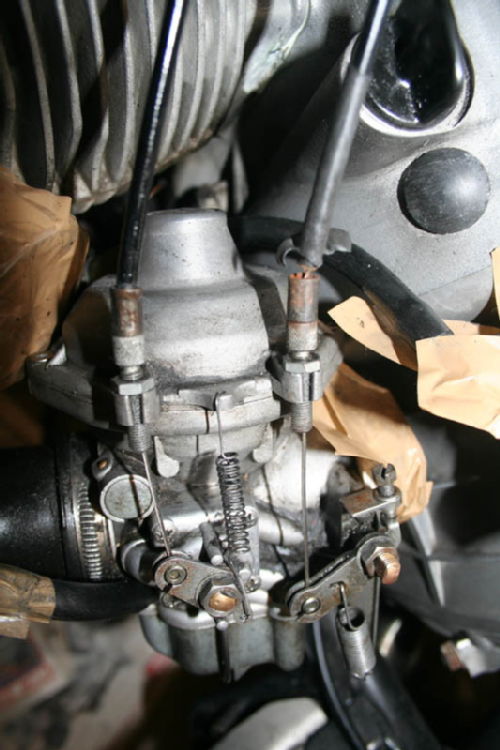
Notice the damaged throttle cable. I replaced it with a new OEM BMW cable. Once reassembled, the throttle and choke action was much improved. I had expected that when starting the engine the carbs would be well out of sync and the idling speed set incorrectly. Amazingly I had guessed almost the correct settings, so have not yet seen the need to use my vacuum guages and the ancient Bing balancing ritual. My plan is to get the bike to an airhead boxer specialist next Saturday (Euroclassics of Northampton) and get the carb settings checked, as well as some good advice on what else needs to be done. This should hopefully confirm my belief that it will be ready for a tour southwards (Spain, Morocco?) at Easter.
All going well except for a puncture. To my great surprise when I wheeled it out of the garage on Saturday the front tyre was flat. It’s a slow one, and there’s no sign of a nail or other object, so perhaps there’s a problem with the seal or the valve. I’m tempted to fit some TKC80 off road tyres, just in case Martin (R1100GS) and I make it to the Merzouga.
More news next week.
January 16, 2007
Jupiter's Travels by Ted Simon – a really great book of travel or migration
- Title:
- Rating:

A very great book, many agree on that. But what kind of book is it? For a while I thought that I could take an interest in the travel writing genre, having enjoyed and learnt greatly from Jupiter’s Travels. I read a lot of travel books. Some are impressive in their own ways. But I remained disappointed. Then recently I read Ted Simon’s classic for a fourth time. Half way through Africa, the second of the journey’s six continents, my mistake became obvious. It’s not really a travel book at all. It is a book of migration, diaspora, escape.
You can, if you want, read Jupiter’s Travels as a great adventure story, which it certainly is. It’s a good, if not the best, motorcycle travel book. If that’s what you want, then just read it. But there’s more. Much more. This is my response to the first two chapters…
Conventional travel books are essentially long postcards dispatched to home. ‘Wish you were here’. Or in some cases, ‘bet you’re glad you’re not here’. Eventually, as we know right from the outset, the writer gets back to the home that was always there. But there is never really a homecoming, or even a home in Jupiter’s Travels (the sequel to Jupiter’s Travels was at one point published as Riding Home, but is now entitled Riding High). Yes, the world was encircled in Simon’s tightening noose. The two ends of the journey, start and finish, twisted around each other on the return to Coventry. The rope tightened…but around thin air. The world had slipped away and refused to be suffocated.
A life, the journey, continued, jumping back and forth across the surface of the world, California, India, France, Romania etc. It continues even now. Part Jewish, part German, part Romanian. Human shrapnel dispersed the First World War and the collapse of the Ottoman Empire. Culturally English, living in America, perhaps even a little bit Indian (spiritually). Part this and part that: Ted Simon – like half the people in the world, on the move, looking for opportunity and experience. A migrant amongst migrants.
Why does this matter? What difference? Travel writing has a recurrent fault: the writer/traveller never really lets go. The journey remains as an interlude within the career. The people and places that are documented never rise above the status of curiosities. The events, the interruptions, are mere diversions. Reality, coincidence, only distracts from the essence of places, or rather landmarks, represented as recollections, travellers tales, postcards, ideals and ideas. But the world is actually full of migrants and coincidences who, to the travel writer, may seem incidental, never true to a place. The vast majority of people in or from the developing world are migrants. Accident, the interconnections between the unstable and shallow surface of things, is the real. Real places, real experiences, which may seem permanent and eternal to the travel writer, are in fact transitory and temporary constructions of coincidence. History (human and natural) proves this, although the power of the travel industry transforms the mistaken apprehensions of the travel writer into self-fulfilling prophecies: places become more like the stories that are told about them. The importance of Ted’s book is that he actually becomes a migrant (or perhaps always was one), and is thus able to encounter the world and its people on their own terms. Being a migrant amongst migrants allows the writer to value people, places and events. I can’t think of single location in its 447 pages that could ever become a new tourist attraction. They are all far too real and minor. Many of them no longer exist, having been swallowed up by development, decay or dessertification. An epic book of an epic journey, never serving the imperialistic colonising travel industry. The philosophers Deleuze and Guattari invented the term ‘minor literature’ to describe writing that comes from migrants and under-dogs. It may still be great literature. Kafka they say is minor literature. But it doesn’t come from the dominant major culture within which it swims. Jupiter’s Travels is part of a related genre: minor travel literature. This is how it’s done…
63,000 miles on that feeble little machine! Hacked together from the Meriden parts bin, amidst a near-death experience for the old Triumph company, and then the total collapse of Midlands industry. Only hours south from that miserable place the crankcase spewed its store of lubrication across the road. Failure in the 1970’s was just part of the plan, quality control to be undertaken by the customer out on the road. It was rebuilt and the journey stuttered into life again.
Half way across Lybia and the engine had already started to self-destruct. In those days a spare piston was just part of any long distance rider’s toolbox. The ability to strip and rebuild an engine somewhere out in the African bush? Taken for granted. And finally, just south of Louis Trichardt in SA (where by coincidence I once broke a gearbox) valves dropped, a sleeve corrugated, rings warped and the piston seized:
“The broken metal had penetrated everywhere and again I was struck by the force of the coincidence that all this havoc had been wrought virtually within sight of Johannesburg”. p.173
The end clearly being both nigh and divinely ordained, any normal person would have bailed out. But Ted Simon is no ordinary person. He still had another four continents to crash through (with increasing grace and understanding): interrogations by the Brazilian police, vast landscapes to carve out, portraits to draw of hundreds of people in detailed miniature, love and ideals, horrible accidents (when fishing not riding), India, and an encounter with destiny.
Apparently, a machine only works when it breaks down. Or as the journey demonstrated:
”...the interruptions were the journey.” p.132
And what a machine! A literary machine, an intellectual machine, a desiring and sometimes paranoiac machine. All wired into the bike, the journey and its improbable rhythms:
“The movement has a complex rhythm with many pulses beating…all this metal in motion, amazing that it can last for even a minute, yet it will have to function for thousands of hours [like a human heart]...Through all these pulses blending and beating I hear a slow and steady beat, moving up and down, three semi-tones apart, a second up, a second down…Is it the pulse of my own body intercepting the sound, modifying it with my bloodstream?” p.28-29
The rhythm is both dependable and on the edge of breakdown. Like consciousness itself. It acts as a single line through time and space against which the world is measured. Marking time both produces and absorbs intensity. And then looking outwards from this beat, time and its extension in space is conquered:
“From Tripoli to Sirte is three hundred miles, and I’m really flying with the engine singing for me and everything rapping along nicely. There’s a lot of rain, but I’m less nervous of the wet now, on tar at least. The land and sea lie flat out forever, and I can see the weather coming maybe fifty miles ahead. I have never seen so much weather. I can see where it begins and where it ends; I can see the blue sky above, and the approaching storms and then the good times beyond. Remarkable. Like having an overview of past and future. I am a world spinning through visible time.” p.53
And at the end of Africa:
“I have just ridden that motorcycle 12,245 miles from London…As I think about it I have a sudden and quite extraordinary flash, something I have never had before and am never able to recapture again. I see the whole of Africa in one single vision, as though illuminated by lightning.” p.183
He is of course that lightning flash, connecting thousands of disparate and ever moving points across the vastness of Africa. That interconnection of surfaces is then his essence, the essence of the migrant. He qoutes Gerard Manley Hopkins on the strangeness of being (he revived the medieval philosophy of Duns Scotus and its notion of coincidental but non-decomposable, un-dissolvable uniqueness and identity: essence through accident).
But how many people need to go through 63,000 miles of pain and pleasure to get a home, to clarify and solidify their own substance?
Why? What motivation? There was something demonic, possessing – not just the fire in the cylinder bores, although the bike is important in itself. Rather some circuit in Ted himself, circulating round and round iteratively, sometimes whirling like a tornado of doubt and fear sucking events into its core. At times the force is intense, a whirlwind ripping across the surface of the Earth. Is the journey there to satiate and extinguish that force entirely? Therapy? Or perhaps travel of this kind, and its writing, is a learning process: the question being how to tame and harness that power. How to live successfully as a migrant? Perhaps that could help us with our conflicts and confusions? In Tunisia the effects start to look dangerous. In Libya and Egypt, the raging Yom Kippur war perhaps distracts the police and the people from the effect. And then in Egypt it comes back even more fiercely:
“Could turbulence and change be ‘carried’ and transmitted like a disease? I knew I had brought excitement into those three lives, but the news from the front was always good. I wondered, unhappily, whether I was destined to leave a trail of grief and misery behind me too.” p.74
This is the fate of the migrant. But by the end of Africa, enough has been learned upon which to form a new way of being a mobile difference engine on the road. That is the art of the migrant. However for a while, when physical movement ceases, these lessons no longer make sense. The journey must be taken up once again. And then by California, the traveller and the reader are to a much greater extent able to stop the extensive spatial movement through space while still retaining an intensive movement on the spot, still governed by the habits of a well practised traveller. At this moment relations with other humans are able to deepen and stabilise, at least for a while. Ted finds love, but as the interconnection, intertwining of a set of mobile and tensile surfaces, soon to spring back into life: Australia and Asia.
Coming soon…

December 08, 2006
100,000 miles on two wheels – the good, the bad and the ugly
Follow-up to More surprising facts about motorcycling from Transversality - Robert O'Toole
The good:
- Just going around any fast and wide sweeping corner with excellent grip and visibility.
- Heavily scented country air being forced through the vents at the front of my helmet.
- 0-60 in 5 seconds on a 15 year old trail-bike, 0-60 in 3.5 seconds on a new Ducati.
- Overtaking a Porsche Boxster out of a right hand bend.
- Every time a complete stranger on a bike signals hello (nod of the head in the UK, wave in SA, shake of the leg in continental Europe).
- Filtering past a Maserati stuck in a mile long line of cars, millions of pounds worth of vehicles, all going nowhere – fools!
- Riding a twisty mountain road with an incredible view, locations including the Pyrenees, Montserrat, Auvergne and Chapman’s Peak Drive in Cape Town.
- Crossing France in a day on back roads.
- Riding dry dirt roads in southern Europe or South Africa.
- Kick starting a BMW 1000cc transverse twin.
The bad:
- Being hit on the head and knocked out by debris at 85mph on the motorway in Catalunya (glad I wasn’t driving a car, it would have come straight through the windscreen).
- Hitting a dead swan at 80mph in the middle lane of the M40.
- Dodging past sheets of glass falling off the back of a lorry on the M40 (I passed the lorry and stopped it).
- Being blown off a motorway while riding an F650 in heavy wind.
- Exhaust valve burn out in the outside lane of the motorway.
- Riding on motorways, especially the Paris Peripherique.
- Falling off in deep mud, glamorous locations including Salisbury Plane, the Ridgeway in Oxfordshire and the Karoo desert.
- Riding at 90mph in the outside lane of a French motorway, and being overtaken by a car with half of its wheels off the road.
- Diesel spills, especially around Warwick University (blame the bus company?)
- Car drivers, van drivers, caravaners.
And the ugly:

..the Moosehead biker gang (notice the complete absence of functioning motorcycles).
December 07, 2006
More surprising facts about motorcycling
Follow-up to Mike Waite – motorcycle roadcraft instructor from Transversality - Robert O'Toole
Some other facts about riding a motorcycle that will surprise car drivers:
- We tend to avoid using our brakes, especially as we enter corners. Bikes have five or more gears and usually a clutch that offers lots of subtle control and feedback. Engine braking is the effect that occurs when changing down a gear. Whereas the powerful front brake on a bike upsets its balance, subtle engine braking slows it down whilst maintaining balance. Some riders also gently touch the brake lever whenever they slow down, so as to warn following drivers.
- Filtering (moving to the front of a line of traffic) is both legal and encouraged by the police system. Of course it can be dangerous, but like most things in motorcycling, there are a whole set of techniques designed to make it safe.
- The majority of motorcyle accidents are not caused by car drivers (the so called SMIDSY or “sorry mate I didn’t see you”). They happen on corners, and are associated with poor cornering technique and too much speed. Using the visual point system aims to eliminate these dangers.
- Our roads are often covered in a film of spilt diesel. This emenates from poorly maintained or over-filled commercial vehicles. In the wet it can be a major threat to bikes. However, it also causes many car accidents. Car drivers are so isolated from the environment that they have no idea why they suddenly lose control. The majority of car fatalities are now caused by “sudden loss of control”.
- Motorcycles are neither cheap nor environmentally friendly. The average fuel consumption is around 40pmg. Sports bikes are as low as 25mpg. Tyres rarely last longer than 10,000 miles, and cost around £100 each. A full service for my BMW costs over £400. It is serviced every 5000 miles. My riding equipment, with armour, cost around £1000.
- Harley Davidson’s are not cool.
- Zen and the Art of Motorcyle Maintenance is nonsense. However Jupiter’s Travels is really great literature.
- Valentino Rossi is a god. Schumacher is a pointless bore.
- The first vehicle to cross the entire American continent on land (except for rivers) was a BMW R100 GS.
- The last vehicle to cross Siberia before global warming makes it impossible will probably be a BMW R1200GS Adventure.
Oh, and of course Ewan McGregor is genuinely hard.

And Charley Boorman? Well he had to put up with a lot.
Mike Waite – motorcycle roadcraft instructor
Follow-up to Being assertive and visible on the road – roadcraft for motorcyclists and cyclists from Transversality - Robert O'Toole
Mike Waite is one of the UK’s most respected instructors. I’ve not ridden with him, but I have heard good reports about his team. Not only does he run advanced training courses using the police roadcraft system, he also has a very good DVD for sale. See Mike’s web site for details.
The web site contains some extracts from the video, as well as some footage recorded from his training sessions. Watch a sample below (click on the triangle to make it play). If you have never ridden a big bike, you will be surprised at just how much technical skill, constant observation and intelligence it requires (if you want to stay alive). There is little comparison with driving a car. Note how the manouverability of the bike is used to its maximum, not only to maintain a safe position, but also to gain a better view of the road.
You will also hear Mike constantly talking about the visual point. This is the point at which the road disappears from view. Riders spend most of their time tracking the visual point. The movement of the point away to the left and to the right indicates the nature of upcoming bends. Also hear how Mike picks out features in the landscape such as telegraph poles and hedges. This is used to infer further information about the road. Modern bikes are so fast and so manouverable that such constant observation and planning is essential.
December 05, 2006
Being assertive and visible on the road – roadcraft for motorcyclists and cyclists
Follow-up to Cross in 3 seconds or you're dead – cycling to Warwick University from Transversality - Robert O'Toole
Recently I mentioned my approach to travelling on the roads:
“I am certainly capable of dominating the road and controlling the drivers”
This is easily misunderstood. It isn’t aggresive at all, it’s about being assertive and visible, but polite.
I follow roadcraft, the police motorcycling system. I have done training in the system, and spend a couple of hours every month practising. It works well. I’ve spent most of my time on two motorised wheels. The system has kept me confidently safe for 100,000 miles (apart from the occasional unavoidable collision with motorway debris). The important point is that it isn’t about aggresion, it is very controlled and considered. It relies on constant information given to other road users, with lots of thank you waves. It is all about being assertive and visible in order to counter the mind–dulling driver psychology that is such a danger to other road users.
Here’s an example: consider the turn into Westwood (the second turn towards Coventry). Can you spot something really dangerous about that junction? The pedestrian refuge just before the junction is placed too close to the junction. This means that if you are turning into Westwood, and have to stop mid turn (due to a pedestrian or some other obstacle), the car behind you will have no where to go. As most motorists do not leave a sufficient gap, there’s a good chance you will get shunted. Most car drivers are surprised by the fact that a motorcycle goes around such a corner significantly slower than a car (for various reasons). So the problem is even worse for motorcyclists. Rear end shunts represent a growing percentage of all bike accidents.
And the answer: control the following cars before you get to the junction. Firstly, get your brake light on early. Then gently slow until the following car is closer, the following car will then be travelling at the same speed. You can then control the speed of the following car so that you can enter the turn at a safe speed without any chance of being shunted. I can give you hundreds of other examples. It’s how you take a potentially dangerous method of transport like motorcycling and make it safer than any other form of transport.
I think many of these principles transfer to cycling. Obviously a cycle has less presence on the road, but the system remains the same:
- Take information.
- Use information (that means think and plan, something that most motorists fail to do).
- Give information (make sure it has been seen and acknowledged – eye contact!).
- Position (getting the required space around you on the road, this is the assertive and confident bit).
- Speed (not so easy on a bike, unless you are Chris May).
- Gear (not so relevant on a bike).
- Accelerate and manouvre.
And say thank you if appropriate.
To get started, read the roadcraft manual There is also a version for car drivers. I wonder if there is an equivalent for cyclists?
And then get trained. You can get advanced motorcycle training from RoSPA, the IAM, and the local police (Bike Safe Training). They all use the police method.
November 22, 2006
Exhaust[ion]
This is what it should look like…

...a bike capable of crossing continents. Unfortunately at the moment it would struggle to cross the driveway…
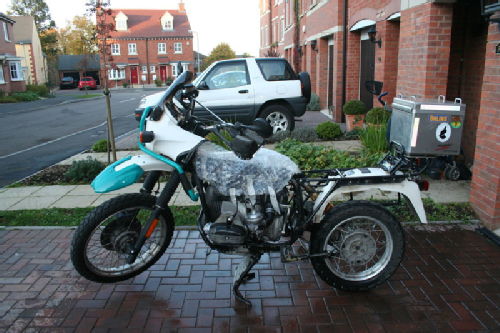
After 78,000 miles, mostly in harsh conditions, it needed a complete strip down. These bikes are capable of massive mileage, but as with any metal object, require occasional TOTAL REFURBISHMENT! Rust has begun to set in. The two most effected components being the lower fork-brace (i think that’s what it is called)...
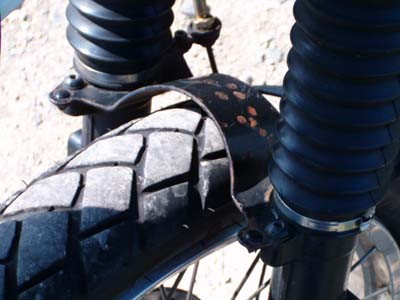
And the battery cage. To start with, I removed them and stripped the rust and paint. The fork-brace was easily re-sprated with Hammerite…
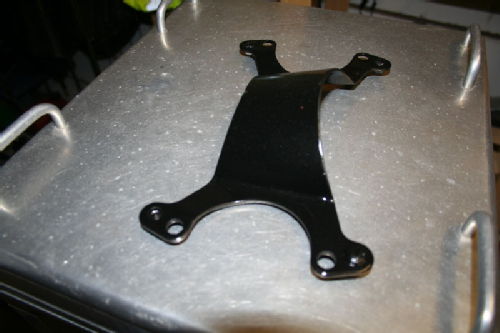
The battery cage is being given an anti-rust treatment before being painted. Removing the battery cage revealed some alarming rust on the Ohlins shock absorber, which cost me £800 only 20,000 miles back…

One of the great things about the R100 GS Paris Dakar is that it was designed to be worked on out in the cuds. The tank and seat clips off in seconds, and the few body panels and crash protectors are cleanly bolted in place. If only removing the exhaust system were so easy. I need to take them off to get at the sides of the lower part of the engine. The down pipes also desperately need replacing, with holes starting to appear in the left hand pipe. The struggle was mighty and prolonged. The down-pipe nuts came off quickly, using the special BMW tool…

This was good news. No serious force can be used to remove them, as this would strip the thread on the engine (expensive). I had expected to be able to simply pull out the down-pipes as a pair, but unfortunately they were seized into place. To progress further I removed the silencer (and attached pannier frame), with the Y-piece still attached. I then tried to seperate the two down-pipes at their crossover. Unfortunately, the left pipe was seized into the crossover. However, it was so rusty that it started to disintegrate. I had no choice but the snap it in half, leaving a rusty shell within the end of the Y-piece, to be dealt with later. Once this was done, I could carefully twist the down-pipes out of their ports.
Here’s the broken down-pipe…
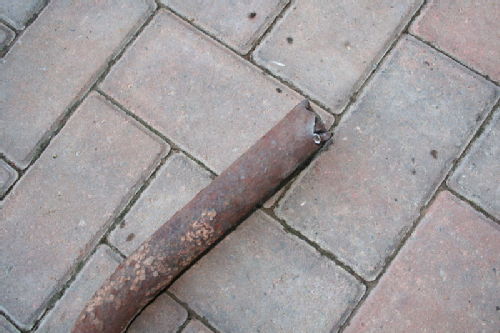
With the pipes off, I could inspect the state of the lower part of the engine. What a mess! It looks as if at least one push-rod seal has blown. This would explain the disappearing engine oil.
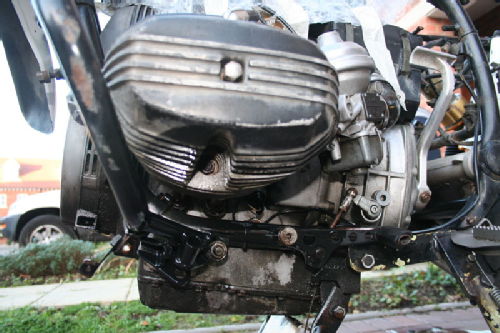
After covering up the open exhaust ports and the electrics, I started to apply Gunk engine degreasant. The first application had only a small effect…

I now have to get all of that gunge off, and then start cleaning the black dirt out of the pitted surface of the engine. I will also use Autosol to give a shine to everything. The frame has more rust than expected, so that will need to be treated as well.
And this is only the start! The pushrod seals need to be replaced. I suspect that a new timing chain is also required. This is all only a temporary fix. Next year I plan to get it professionaly refurbished and powder coated.
August 08, 2006
A seizure, a bypass, and a very fast bike
How many goats must be sacrificed before beginning the starting procedure? In these modern politically correct times we no longer sacrifice virgins. Goats yes: messy but legal. Virgins no: messy, illegal, very much so. Such bloodlettings are only one of many requirements:
- check the petrol taps are on;
- estimate the exact degree of choke using a complex algorithm combining the ambient air temperature with the quantity of oil in the sump and the latent heat in the pistons (or just guess and get it wrong);
- put the bike on its centre stand;
- pray to the correct pantheon of Germanic gods;
- sacrifice goats (not virgins);
- sign Satanic pact (in blood) henceforth dedicating one's soul to the Antichrist;
- mount BMW motorcycle;
- place heal of boot onto the kick starter;
- gently pump the kick starter up and down for anything up to half an hour;
- be amazed when sufficient compression is generated in the 1000cc lump so that firing commences;
- rev the engine at exactly the right time in exactly the correct manner so as to keep the cylinders firing;
- don't ever stop reving the engine until it is thoroughly warmed up (ten miles of riding is usually sufficient).
Starting a 13 year old BMW R100 GS Paris Daker desert racer without an electric starter motor is a fairly futile task. But occassionaly, thanks to BMW reliability, the task is unavoidably necessary. A single click from the ignition system had made the situation quite clear. The starter had seized. This might have been a side effect of a high speed 200 mile non–stop blast between Kenilworth and Dorchester the day before. But I suspect that the bike just realised that it was only 10 miles from its spiritual home (the dealer from whence it came). It is often uncanny in this manner.
And so, only a few minutes after deciding to give in and buy myself one of the wonderful new R1200GS rocket bikes, I was again back on track. Had I been riding a modern bike I would still be waiting for the tow truck. The R100GS was one of the last bikes to be equipped with a kick start, the idea being that electrics do fail quite easily when riding far out in its natural environment, the Sahara.
My arrival at CW's caused a minor stir. The GS–PD is a rare sight. Wally, top technical man, had come in specially to supervise work on what seems to be one of his favourites. In the past he has replaced the gearbox, shaft drive, brakes, one exhaust valve, and various other bits under warranty. Now being out of warranty (over ten years old), I would have to pay for a new starter motor myself: £175. I would also have to wait for a few days – not part of my agenda. Wally is also recommending that he fit a bypass to cut out the oil cooler, which is now rather old and a potential problem. Common wisdom claims that the cooler isn't really required, unless riding in the desert, and in fact the engine runs better without it. I have given him a Touratech bypas kit to apply.
Having amazed everyone with my kick–start miracle, I sat down for a while to chat with Wally and Neil. Wally has a theory about kick starting: it is a genetically inherited skill, or rather, some kind of primeval drive. Some people have it, other don't. He also claims that it guarantees success with the ladies! I'm not sure about that. But it certainly did get me tio CW's, from whom I departed a couple of hours later riding a loan bike. A very fast loan bike: a new R1150R naked roadster on which I could bimble around Dorset, ride back to Kenilworth, and then return in a few days to collect the GS PD. Excellent service as usual.

BMW R1150R – a sexy black naked roadster. Fast, manouverable, moderately comfortable (legs a bit too cramped). I even managed to get the front wheel to slide in a corner. The telelever front suspension is often blamed for this habit – it makes the bike much more stable, but also isolates the rider from the traction, making it hard to know when it is losing grip.
May 07, 2006
My Oxford top 10
- The Radcliffe Arms, Jerico. A very ordinary, old–fashioned and down–to–earth pub in one of Britain's most expensive neighbourhoods. Good beer, and good cheap food. Excellent for Sunday roast.
- Walking along the Thames into Oxford, from the Abingdon Park and Ride to the Head of the River pub. On weekend mornings you can see boat crews exercising out on the river. From the pub, you can continue through Christ Church Meadows to the Botanical Gardens, and then across to the Parks and out the other side of Oxford. There is a bus back to the Park and Ride from the city centre.
- Walking through Port Meadow from the Botley Road to the The Trout Inn. The water meadow is an interesting environment, with lots of open space and lots to see. A good place for a picnic, except for the hordes of angry political geese
- Borders coffee shop. Each of the three book shops in Oxford have good cafes. However, the Borders cafe is right next to the philosophy section, which contains a decent selection of interesting books, often with plenty of Deleuze.
- Edamame, 15 Holywell Street. A tiny Japanese restaurant serving what I am told is the kind of food that the Japanese really eat (ie not sushi). We first went there with a friend who has lived in Japan. The food is excellent, although the seating system is very un–English. You have to share your table with anyone else seeking a space.
- The Fishes pub and restaurant in North Hinksey. Next to a small river, with a large garden and a play area for Mooseheads. Excellent and sensibly priced food. It has been refurbished recently, so may have changed.
- The Aziz. 230 Cowley Road. Of Oxford's many good Indian Restaurants, this is my favourite. Good friendly service, even for large groups of drunken e–learning advisors.
- Oxford Coffee Concerts at the Holywell Music Room. Concerts of classical music, Sundays 11:15.
- Oxford University Museum of Natural History. Free entry. Voracious dinosaurs.
- Moosehead Manor, Botley. Exclusive club for learning technologists and other miscellaneous flotsam. Luxury accommodation. Entertaining host, speaks Russian, Romanian, Portuguese and English (when sober). Vast array of kitchen gadgets. Endless supply of scotch bonnet chillis. Fascinating and colourful history. Opposite Andy Brock's butchery, hence ideal for serious fry–ups.
February 18, 2006
Travel Report: Underwater Africa
Follow-up to Travel Report: Lawrence on safari from Transversality - Robert O'Toole
Our swimming teacher claims that babies keep their eyes open under water. Lawrence doesn't agree:
Whilst on holiday, he swam every day. Soon he had begun to kick his feet and use his arms. He is also capable of easily keeping his head above water.
February 13, 2006
Travel Report: Lawrence on safari
Follow-up to Travel Report: Lawrence of Africa from Transversality - Robert O'Toole
Steve Irwin says it's perfectly safe…
"Faster, faster, make them fly…"
"Daddy, why have those trees got eyes and beaks?"
…and seconds later the 20 foot long crocodile lept out of the water.
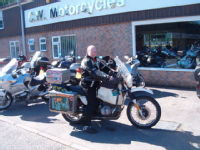
 Robert O'Toole
Robert O'Toole

 Please wait - comments are loading
Please wait - comments are loading







